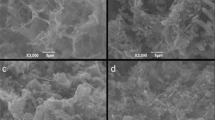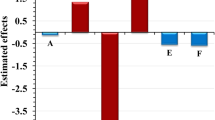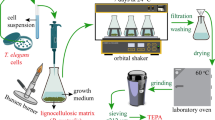Abstract
A novel biomaterial was prepared by the immobilization of Phlebia gigantea cells in the medium containing lignocellulosic waste and used for the first time in the bioremediation purpose. The developed new biocomposite possesses higher Pb(II) retention potential when compared with the free microbial cells. It could remove Pb(II) up to 74.11% at a biosorbent dosage of 4.0 g L−1. Surface characterization was carried out through zeta potential, EDX, SEM, and IR studies to understand the metal-biocomposite interactions. The biosorption amount at equilibrium slightly decreased with the increase of the solution temperature. Kinetic data indicated Pb(II) biosorption onto suggested biocomposite fits well with the pseudo-first-order model. Biosorption equilibrium data suited Langmuir model with the highest coefficient of determination values. The immobilized material reached to maximum monolayer Pb(II) retention capacity (1.449 × 10−4 mol g−1) within the short equilibrium time (10 min). The designed biocomposite was also adapted to continuous flow mode sorption process. Regeneration tests by dynamic flow mode confirmed reutilization potential of biocomposite.





Similar content being viewed by others
References
Abbas M, Kaddour S, Trari M (2014) Kinetic and equilibrium studies of cobalt adsorption on apricot stone activated carbon. J Ind Eng Chem 20:745–751
Ahmad T, Danish M (2018) Prospects of banana waste utilization in wastewater treatment: a review. J Environ Manag 206:330–348
Ahmad AA, Hameed BH (2010) Fixed-bed adsorption of reactive azo dye onto granular activated carbon prepared from waste. J Hazard Mater 175:298–303
Ahsan MA, Islam MT, Imam MA, Hyder AHMG, Jabbari V, Dominguez N, Noveron JC (2018) Biosorption of bisphenol A and sulfamethoxazole from water using sulfonated coffee waste: isotherm, kinetic and thermodynamic studies. J Environ Chem Eng 6:6602–6611
Akar T, Celik S, Gorgulu Ari A, Tunali Akar S (2013) Removal of Pb2+ ions from contaminated solutions by microbial composite: combined action of a soilborne fungus Mucor plumbeus and alunite matrix. Chem Eng J 215-216:626–634
Akar T, Güray T, Yilmazer DT, Tunali Akar S (2019) Biosorptive detoxification of zearalenone biotoxin by surface-modified renewable biomass: process dynamics and application. J Sci Food Agric 99:1850–1861
Bhatnagar A, Sillanpää M (2010) Utilization of agro-industrial and municipal waste materials as potential adsorbents for water treatment—a review. Chem Eng J 157:277–296
Bhatti HN, Bajwa II, Hanif MA, Bukhari IH (2010) Removal of lead and cobalt using lignocellulosic fiber derived from Citrus reticulata waste biomass. Korean J Chem Eng 27:218–227
Blázquez G, Calero M, Hernáinz F, Tenorio G, Martín-Lara MA (2010) Equilibrium biosorption of lead(II) from aqueous solutions by solid waste from olive-oil production. Chem Eng J 160:615–622
Bueno BYM, Torem ML, de Carvalho RJ, Pino GAH, de Mesquita LMS (2011) Fundamental aspects of biosorption of lead (II) ions onto a Rhodococcus opacus strain for environmental applications. Miner Eng 24:1619–1624
Bulgariu D, Bulgariu L (2016) Potential use of alkaline treated algae waste biomass as sustainable biosorbent for clean recovery of cadmium(II) from aqueous media: batch and column studies. J Clean Prod 112:4525–4533
Bulgariu L, Bulgariu D, Malutan T, Macoveanu M (2009) Adsorption of lead(II) ions from aqueous solution onto lignin. Adsorpt Sci Technol 27:435–445
Campoy S, Álvarez-Rodríguez ML, Recio E, Rumbero A, Coque JJR (2009) Biodegradation of 2,4,6-TCA by the white-rot fungus Phlebia radiata is initiated by a phase I (O-demethylation)–phase II (O-conjugation) reactions system: implications for the chlorine cycle. Environ Microbiol 11:99–110
Çay S, Uyanık A, Özaşık A (2004) Single and binary component adsorption of copper(II) and cadmium(II) from aqueous solutions using tea-industry waste. Sep Purif Technol 38:273–280
Chandra Sekhar K, Kamala CT, Chary NS, Anjaneyulu Y (2003) Removal of heavy metals using a plant biomass with reference to environmental control. Int J Miner Process 68:37–45
Dhanarani S, Viswanathan E, Piruthiviraj P, Arivalagan P, Kaliannan T (2016) Comparative study on the biosorption of aluminum by free and immobilized cells of Bacillus safensis KTSMBNL 26 isolated from explosive contaminated soil. J Taiwan Inst Chem Eng 69:61–67
Dubinin M, Radushkevich L (1947) Evaluation of microporous materials with a new isotherm. Dokl Akad Nauk SSSR:331–334
Dzionek A, Wojcieszyńska D, Guzik U (2016) Natural carriers in bioremediation: a review. Electron J Biotechnol 23:28–36
Elwakeel KZ, Al-Bogami AS (2018) Influence of Mo(VI) immobilization and temperature on As(V) sorption onto magnetic separable poly p-phenylenediamine-thiourea-formaldehyde polymer. J Hazard Mater 342:335–346
Essien JP, Akpan EJ, Essien EP (2005) Studies on mould growth and biomass production using waste banana peel. Bioresour Technol 96:1451–1456
FAO (2018) Banana facts and figures. http://www.fao.org/economic/est/est-commodities/bananas/bananafacts/en/#.XRMqQ4-hnIU (accessed 20 Dec 2018)
Freundlich H (1906) Über die adsorption in lösungen. Z Phys Chem 57:385–470
Ghaedi M, Ghezelbash GR, Marahel F, Ehsanipour S, Najibi A, Soylak M (2010) Equilibrium, thermodynamic, and kinetic studies on lead (II) biosorption from aqueous solution by Saccharomyces cerevisiae biomass. Clean Soil Air Water 38:877–885
Guerrero AB, Ballesteros I, Ballesteros M (2018) The potential of agricultural banana waste for bioethanol production. Fuel 213:176–185
Guyo U, Mhonyera J, Moyo M (2015) Pb(II) adsorption from aqueous solutions by raw and treated biomass of maize stover – a comparative study. Process Saf Environ Prot 93:192–200
Hadiani MR, Darani KK, Rahimifard N, Younesi H (2018) Biosorption of low concentration levels of lead (II) and cadmium (II) from aqueous solution by Saccharomyces cerevisiae: response surface methodology. Biocatal Agric Biotechnol 15:25–34
Han R, Zhang J, Zou W, Shi J, Liu H (2005) Equilibrium biosorption isotherm for lead ion on chaff. J Hazard Mater 125:266–271
Kadimpati KK (2017) Design of hybrid PVA–CA–Jania rubens biomatrix for removal of lead. Int J Phytoremediation 19:183–190
Kareem SO, Rahman RA (2013) Utilization of banana peels for citric acid production by Aspergillus niger. Agric Biol J North Am 4:384–387
Kariuki Z, Kiptoo J, Onyancha D (2017) Biosorption studies of lead and copper using rogers mushroom biomass ‘Lepiota hystrix’. S Afr J Chem Eng 23:62–70
Langmuir I (1918) The adsorption of gases on plane surfaces of glass, mica and platinum. J Am Chem Soc 40:1361–1403
Lin CC, Lai YT (2006) Adsorption and recovery of lead(II) from aqueous solutions by immobilized Pseudomonas aeruginosa PU21 beads. J Hazard Mater 137:99–105
Mahmoud ME, El Zokm GM, Farag AEM, Abdelwahab MS (2017) Assessment of heat-inactivated marine Aspergillus flavus as a novel biosorbent for removal of Cd(II), Hg(II), and Pb(II) from water. Environ Sci Pollut Res 24:18218–18228
Martín-Lara MÁ, Rico ILR, Vicente IDLCA, García GB, de Hoces MC (2010) Modification of the sorptive characteristics of sugarcane bagasse for removing lead from aqueous solutions. Desalination 256:58–63
Mohapatra RK, Parhi PK, Pandey S, Bindhani BK, Thatoi H, Panda CR (2019) Active and passive biosorption of Pb (II) using live and dead biomass of marine bacterium Bacillus xiamenensis PbRPSD202: kinetics and isotherm studies. J Environ Manag 247:121–134
Morosanu I, Teodosiu C, Paduraru C, Ibanescu D, Tofan L (2017) Biosorption of lead ions from aqueous effluents by rapeseed biomass. New Biotechnol 39:110–124
Osma JF, Toca Herrera JL, Rodríguez Couto S (2007) Banana skin: a novel waste for laccase production by Trametes pubescens under solid-state conditions. Application to synthetic dye decolouration. Dyes Pigments 75:32–37
Parmar HS, Kar A (2008) Medicinal values of fruit peels from Citrus sinensis, Punica granatum, and Musa paradisiaca with respect to alterations in tissue lipid peroxidation and serum concentration of glucose, insulin, and thyroid hormones. J Med Food 11:376–381
Ronda A, Martín-Lara MA, Calero M, Blázquez G (2013) Analysis of the kinetics of lead biosorption using native and chemically treated olive tree pruning. Ecol Eng 58:278–285
Saha GC, Hoque MIU, Miah MAM, Holze R, Chowdhury DA, Khandaker S, Chowdhury S (2017) Biosorptive removal of lead from aqueous solutions onto Taro (Colocasiaesculenta (L.) Schott) as a low cost bioadsorbent: characterization, equilibria, kinetics and biosorption-mechanism studies. J Environ Chem Eng 5:2151–2162
Senthil Kumar P (2014) Adsorption of lead(II) ions from simulated wastewater using natural waste: a kinetic, thermodynamic and equilibrium study. Environ Prog Sustain Energy 33:55–64
Taty-Costodes VC, Fauduet H, Porte C, Ho YS (2005) Removal of lead (II) ions from synthetic and real effluents using immobilized Pinus sylvestris sawdust: adsorption on a fixed-bed column. J Hazard Mater 123:135–144
Tewari N, Vasudevan P, Guha BK (2005) Study on biosorption of Cr(VI) by Mucor hiemalis. Biochem Eng J 23:185–192
Tibolla H, Pelissari FM, Menegalli FC (2014) Cellulose nanofibers produced from banana peel by chemical and enzymatic treatment. LWT Food Sci Technol 59:1311–1318
Vieira MGA, de Almeida Neto AF, da Silva MGC, Carneiro CN, Melo Filho AA (2014) Adsorption of lead and copper ions from aqueous effluents on rice husk ash in a dynamic system. Braz J Chem Eng 31:519–529
Vinod VTP, Sashidhar RB, Sreedhar B, Rama Rao B, Nageswara Rao T, Abraham JT (2009) Interaction of Pb2+ and Cd2+ with gum kondagogu (Cochlospermum gossypium): a natural carbohydrate polymer with biosorbent properties. Carbohydr Polym 78:894–901
Xing SC, Chen JY, Lv N, Mi JD, Chen WL, Liang JB, Liao XD (2018) Biosorption of lead (Pb2+) by the vegetative and decay cells and spores of Bacillus coagulans R11 isolated from lead mine soil. Chemosphere 211:804–816
Xu P, Zeng GM, Huang DL, Lai C, Zhao MH, Wei Z, Li NJ, Huang C, Xie GX (2012) Adsorption of Pb(II) by iron oxide nanoparticles immobilized Phanerochaete chrysosporium: equilibrium, kinetic, thermodynamic and mechanisms analysis. Chem Eng J 203:423–431
Zhou K, Yang Z, Liu Y, Kong X (2015) Kinetics and equilibrium studies on biosorption of Pb(II) from aqueous solution by a novel biosorbent: Cyclosorus interruptus. J Environ Chem Eng 3:2219–2228
Funding
This study has been financially supported by Commission of the Scientific Research Projects of Eskişehir Osmangazi University (project number 201719A106).
Author information
Authors and Affiliations
Corresponding author
Additional information
Responsible editor: Tito Roberto Cadaval Jr
Publisher’s note
Springer Nature remains neutral with regard to jurisdictional claims in published maps and institutional affiliations.
Rights and permissions
About this article
Cite this article
Akar, T., Aydın, P., Celik, S. et al. Phlebia gigantea cells immobilized on renewable biomass matrix as potential ecofriendly scavenger for lead contamination. Environ Sci Pollut Res 27, 16177–16188 (2020). https://doi.org/10.1007/s11356-020-07889-z
Received:
Accepted:
Published:
Issue Date:
DOI: https://doi.org/10.1007/s11356-020-07889-z




